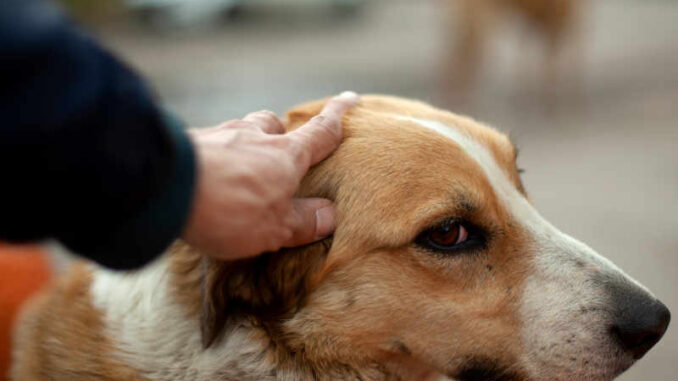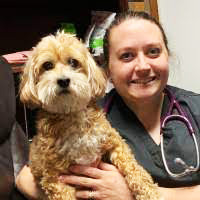
This article was updated on September 1st, 2023

Have you noticed that your dog has a bump on their head between their ears? While bumps are typically cause for alarm, all dogs have a bump near the back of their head called an occiput.
The bump can vary in size and roundness depending on your dog’s breed, but it’s a normal part of your dog’s anatomy.
Dog occiput: What is that bump on your dog’s head?
The occiput, or occipital bone, takes its name from the Latin word for “back of the skull.” It’s the part of the skull that connects to your dog’s neck and acts as a passage for their spinal cord, allowing your dog to move their head in relation to their spine.

The size will depend on your dog’s breed. Some dog breeds will have a pronounced occiput that’s easy to feel through the skin of their head, while others will have a smaller bump. Hounds, for example, are known for having a pronounced occiput.

Because the bump is a part of your dog’s skull, it should remain around the same size throughout your dog’s life unless there’s a medical issue.
Why does my dog have an occiput?
In folklore, it’s believed that the size of the bump on your dog’s head signifies their intelligence, and many people still refer to the bump as the “knowledge bump” or the “wisdom bump.”
Others believed that there was a connection between the size of the bump and the dog’s sense of smell, likely because hounds—breeds known for their keen sense of smell—have prominent occiputs.
While the size of the bump has no correlation with how smart your dog is, the occiput does exist to protect your dog’s brain, as well as other bones in your dog’s skull. Historically, the protrusion helped protect your dog’s skull from sharp bites from predators. It also helps assist with your dog’s head movements, with muscles from the neck attached here.
Occiputs are a natural part of every dog’s anatomy, but size can vary
They are a natural part of the anatomy, but the size and shape of the occiputs will differ depending on your dog’s breed. In some dogs, the bump will be more noticeable, while you may have to feel for the bump in other breeds.
While occiputs are naturally occurring for your dog, changes in their size and shape can be a sign of an underlying health condition.
Should I monitor my dog’s occiput over time?
In most cases, the bump on your dog’s head will stay the same size throughout their lives, but you should still keep an eye on it over time. If you notice that your dog has a swollen occiput or the appearance has changed over time, you should contact your veterinarian.
Is there ever a reason to worry about it?
The main sign that you should seek guidance from a veterinarian is if you notice that your dog’s occiput has gotten larger or more noticeable, especially for a longer period of time. Other signs that you should see a vet include:
- If the bump is warm to the touch
- If the bump causes noticeable discomfort in your dog
- If you can move the bump around with your hands
While there are many explanations, it could also be the first warning signs of an oncoming illness, so it’s always better to be safe than sorry.
Can a dog’s occiput get bigger?
Your dog’s occiput should stay the same size throughout their life, with the exception of during adolescence when they start to mature. The bump could temporarily appear larger while your dog’s body is still growing and they’re going through skeletal development.
For small dog breeds, they’ll likely reach maturity at 10 to 12 months, while larger dog breeds can take up to 18 to 24 months to fully develop.
If your dog has reached maturity and you see that their occiput has changed size, it could mean that your dog has lost muscle mass around the back of their skull. There are a variety of conditions that can cause muscle atrophy, including cancer, so it’s important to contact your vet right away.
Because some breeds have a more pronounced occiput, it’s also possible for your dog to hit or injure that part of their skull more regularly, resulting in bruises. If your dog gets a bruise on that area of their skull, it can also make the occiput appear to be bigger.
What breeds have a pronounced occiput?
Every dog has a bump on their head, but there are a variety of breeds that have a more pronounced occiput. Many hound breeds are known to have a more noticeable bump on their head, as well as other sporting breeds.
In most cases, the larger the dog breed, the more prominent the occiput. A few popular breeds with large bumps on their head include:
- Bloodhounds
- Labrador Retrievers
- Golden Retrievers
- English Setters
- English Pointers
- Collies
- Cocker Spaniels
- Basset Hounds
- Doberman Pinschers
- German Shepherds
Is it found in species other than dogs?
Dogs aren’t the only species that have an occiput—it’s a common part of the anatomy of many mammals, including humans.
While it’s more pronounced in dogs, most mammals have an occiput near the back of their skull that helps facilitate the mobility of their head, neck, and upper cervical spine. In humans, the occipital bone is flat, but it serves the same purpose of protection and mobility.
Disclaimer: This website's content is not a substitute for veterinary care. Always consult with your veterinarian for healthcare decisions. Read More.


Our Aussie got very sick, drank huge amounts of water one night and later threw up lots of water. We took him to our vet in the morning. He was diagnosed with diabetes. The next day we got
To see him and he had a big bump on his head. We were told it
Was from dehydration. That was Feb 18. It’s still there on May 28. We never found anything online about this bump associated with
Dehydration or diabetes. So could that be what caused this?